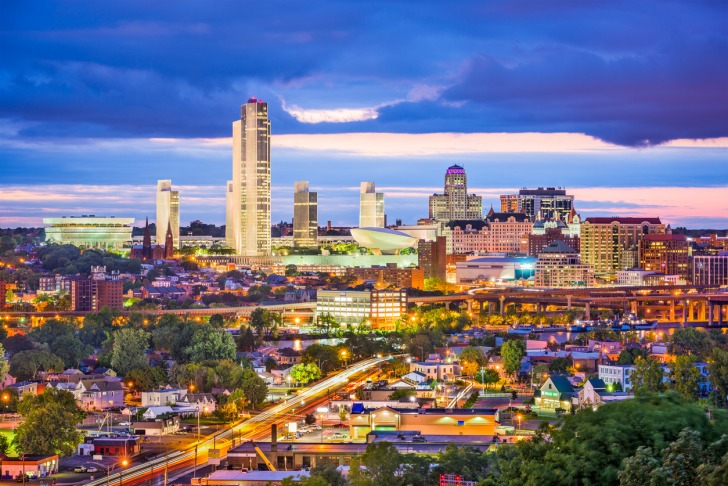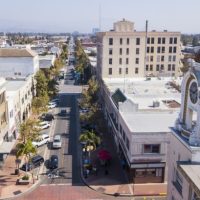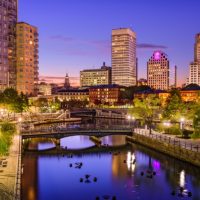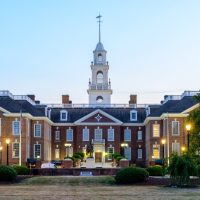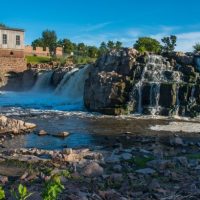What’s it like to live in Albany, the capital of New York?
Albany is a historical city with beautiful architecture and small-town charm.
Its prestigious colleges make it a good place to further your education.
Affordable living and a healthy economy are yet more reasons to consider making Albany your home.
Before taking the plunge, it’s good to review the city’s pros and cons.
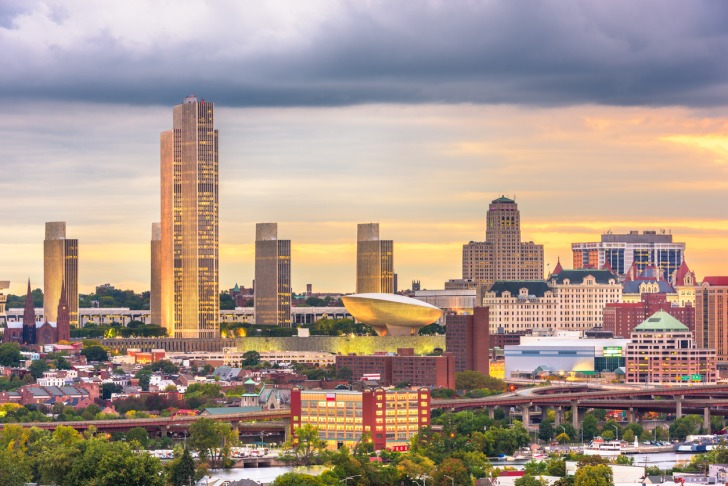
Contents
Pros of Living in Albany, NY
There are numerous advantages to relocating to Albany, NY.
Many of these advantages are financial, such as:
1. Affordable Living Costs
It’s cheaper to live in Albany than it is in New York City or other cities comparable to its size around the country.
Living expenses in Albany are roughly 29% cheaper than in NYC, not counting your rent.
Housing and rental costs are notably less than in other major Northeastern cities.
The cost of a single-family home averages around $200,000 while a two-bedroom apartment rents for about $1,600 a month.
Your healthcare, grocery, and transportation bills are lower than in other cities in this region.
Living in Albany gives you the New York experience at an affordable cost.
2. Healthy Economy
Albany lies in the center of New York’s Tech Valley, the Capital Region’s hub for technology and education.
Here you’ll find companies like Rational Enterprise, CommerceHub, and GCOM to help expand your technology career.
Additional industries include education, healthcare, manufacturing, financial services, and the state government.
Over a third of the city’s population is employed by the state government.
IBM, GE, the University of Albany, and St. Peter’s Health Partners are other top employers.
Newbies to the area will have ample opportunity to find gainful employment.
3. Higher Education
If you’re after higher education, you’ve come to the right spot!
New York’s capital is home to 7 colleges, including the U of Albany, Bryant & Stratton College, and the College of Saint Rose.
An additional 28 colleges can be found in the surrounding areas.
The U of Albany offers over 50 undergrad majors & minors along with 150 graduate programs.
You can study business, education, engineering, environmental sciences, and dozens of other careers.
As an extra perk, NY residents get in-state tuition rates to help pay for their college studies.
4. Location
Albany is centrally located, making intercity travel convenient by train or car.
A 3-hour drive puts you in Boston, Montreal, or New York City.
Albany’s proximity to major highways and airports facilitates both leisure and business travel.
From Albany, business trips to NYC or cultural expeditions to Boston are well within your reach.
You can enjoy all the amenities that larger cities have to offer without actually having to live there!
5. Cultural Attractions
Albany’s rich cultural heritage can be explored through its local architecture and museums.
You can learn more about the history, peoples, and wildlife of the region at the New York State Museum.
View beautiful displays of art at local galleries like The Opalka, Albany Center, or Upstate Artists Guild.
For a peek into the Hall of New York and legislative chambers, you can schedule a tour of the State Capitol.
Or you can catch a concert, comedy show, or theatrical performance at The Egg.
You also don’t want to miss a trip to Lark Street, the city’s hub for shopping and dining.
6. Outdoor Recreation
Albany is surrounded by rivers, lakes, mountains, and forests for outdoor enjoyment.
You can kayak, swim, fish, or go boating on the Hudson or Mohawk River, both of which border the city.
The city is home to lush, green parks where you can hike, bike, bird watch, or picnic with your family.
During winter, you can take a trip to the Adirondack Mountains for skiing, snowshoeing, or snowboarding.
Living in Albany gives you easy access to vacation hotspots like the Catskills and Lake George for year-round outdoor fun!
7. Seasonal Changes
Like most northern cities, Albany has very distinct and pronounced seasonal changes.
If you’re a fan of hot, sunny summers and cold, snowy winters, Albany won’t disappoint.
During the fall, the city comes to life with the vibrant fall foliage colors of red, yellow, and orange.
A drive to John Boyd Thacher State Park offers majestic views of the Hudson-Mohawk Valley in all its autumn glory.
In winter, you can cuddle in front of the fire or hit Maple Ski Ridge for a day of skiing or snowboarding.
Summer heat and winter cold are sandwiched in between moderate temperatures during spring and fall.
8. Local Breweries
The beer industry is popping up in New York with new breweries and microbreweries on the rise.
Of the 350+ breweries located in the state, 20 can be found in Albany.
Local favorites include C H Evans, Druthers, Fidens, and Fort Orange Brewing Company.
Many of Albany’s breweries offer food and live music along with their drinks so that you can celebrate with friends and family.
In Albany, there’s nothing like ending a long work day or work week with a cold blonde ale, IPA, or stout.
Cons of Living in Albany, NY
Before relocating to Albany, NY, newbies should check out the drawbacks of living in this town.
These include:
1. Freezing Cold Winters
Winters are VERY cold in Albany and are accompanied by lots of snow.
Freezing temperatures can last for months and the city averages around 59 inches of snow annually.
Severe snowstorms can disrupt travel and may cause schools and businesses to close.
If you’re not used to driving on icy, snowy roads, you’re at risk of causing an accident.
Although the city plows and salts the streets and sidewalks, winter weather can be precarious.
2. Hot, Humid Summers
On the flip side, Albany summers can be extremely hot due to high humidity.
High humidity levels can make temperatures feel much hotter and more oppressive than they really are.
July and August are the worst months when humidity levels can rise up to 60%.
During this time, it can be extremely uncomfortable to be outdoors.
Hot, humid weather can also lead to the growth of mold and mildew in your home.
3. High Property Taxes
If you plan to buy a home, you should know Albany County’s high property taxes.
Albany homeowners pay around 2.17% of their property’s assessed value in taxes.
This percentage is higher than both the national and state average.
Through property taxes, however, you help fund public schools, roads, and city governance.
The low cost of housing helps offset some of the property tax costs, making it more manageable.
4. Limited Public Transport
Public transport isn’t one of Albany’s strong suits.
The city does have a bus system, but its routes are limited and schedules irregular, making bus travel unreliable.
Albany’s train system is for intercity travel, connecting residents with major cities around the area.
Train travel, however, can be costly and not for everyone.
Your best bet for getting around the area is using your own car.
5. Influx of College Students
The city’s colleges and universities attract a large influx of young college students.
This contributes to traffic congestion and makes parking a bit more difficult to find.
Concerts, festivals, and sports events may draw even more crowds as students from nearby cities join in on the fun.
If you live near a college campus, expect noise and rowdiness.
Local restaurants, breweries, shops, and other attractions may also get crowded.
6. Traffic/Parking Problems
Downtown traffic in Albany can be tedious as the infrastructure doesn’t always concur with the flow of traffic.
It’s not unusual to get stuck at a light, inching along for some time.
Traffic can become congested during rush hour or when the colleges hold special events.
Working with a traffic app could be helpful in avoiding traffic jams.
Lack of parking is another issue drivers face when going to work or spending time downtown.
These problems are worth considering if you plan to make Albany your new home.
7. Derelict Properties
Being an older city, it’s natural for Albany to have some older or derelict properties.
The trouble comes when derelict buildings are found close to quality housing in nice neighborhoods.
Derelict properties can lower the value of quality housing in good neighborhoods or make them less appealing to buyers.
Older apartment buildings are also more prone to plumbing and electricity problems as well as issues with pests.
8. Poverty/Homelessness
Statistics show that almost 22% of Albany’s population is living in poverty.
That’s almost 1 out of every 4 people in the city.
When people are impoverished, homelessness isn’t far behind.
There seems to be a large division between the “haves” and “have-nots” in Albany.
Financial inequality further aggravates poverty and homelessness problems.
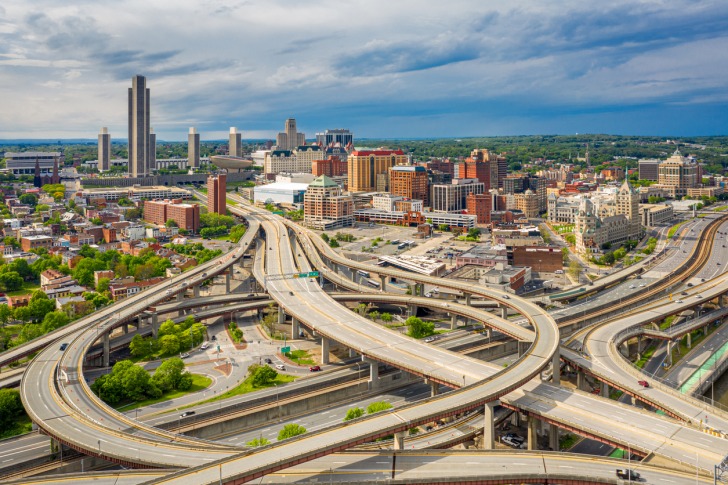
Pros and Cons of Living in Albany, NY – Summary Table
| Pros of Living in Albany, NY | Cons of Living in Albany, NY |
|---|---|
| 1. Affordable Living Costs | 1. Freezing Cold Winters |
| 2. Healthy Economy | 2. Hot, Humid Summers |
| 3. Higher Education | 3. High Property Taxes |
| 4. Location | 4. Limited Public Transport |
| 5. Cultural Attractions | 5. Influx of College Students |
| 6. Outdoor Recreation | 6. Traffic/Parking Problems |
| 7. Seasonal Changes | 7. Derelict Properties |
| 8. Local Breweries | 8. Poverty/Homelessness |
Albany Safety Overview
READ THE FULL REPORT: Albany Safety Review
Safety Index:
- OVERALL RISK: LOW
- TRANSPORT & TAXIS RISK: LOW
- PICKPOCKETS RISK: MEDIUM
- NATURAL DISASTERS RISK: MEDIUM
- MUGGING RISK: LOW
- TERRORISM RISK: MEDIUM
- SCAMS RISK: MEDIUM
- WOMEN TRAVELERS RISK: LOW
Frequently Asked Questions
What role does Albany play in New York?
Albany is the capital of New York State and the cultural and economic center of the Capital Region.
It’s the seat of State Government and the home of the University of Albany and other prestigious colleges.
Is it safe to live in Albany, NY?
The crime rate in Albany is lower than the U.S. average for both violent and property crimes.
Some areas of the city, however, are not as safe as others.
By avoiding questionable areas and taking necessary precautions, you can avoid being a victim of crime.
What are some safe and affordable neighborhoods in Albany, NY?
Buckingham Lake-Crestwood and Helderberg are good neighborhoods for families as they’re quiet, tight-knit communities with good schools.
Center Square in downtown Albany is more conducive for singles and professionals due to the nightlife, shopping, and youthful appeal.
Pine Hills is good for students due to its proximity to both the U of Albany and College of St. Rose campuses.
Is Albany, NY the oldest city in the country?
Albany was claimed as a Dutch colony by Henry Hudson in 1609.
In 1686, it was chartered as a city, making it the 2nd oldest U.S. chartered city after St. Augustine in Florida.
Albany became the state capital in 1797.
What are Albany’s biggest industries?
State government and health care are two prominent industries in Albany.
In the private sector, health care comes out on top, with one out of four jobs being connected to this field.
